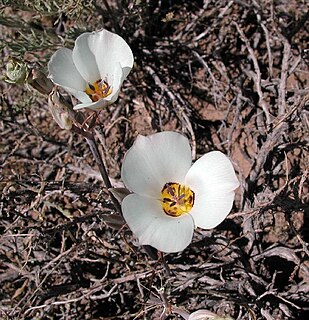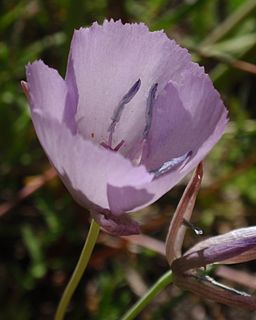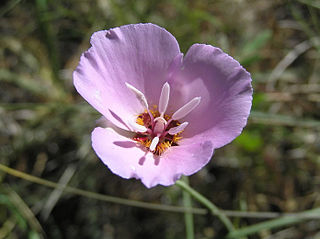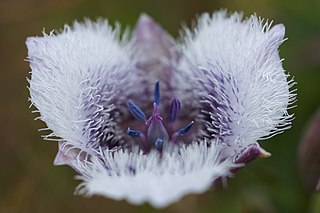
Platystemon is a monotypic genus of flowering plants in the poppy family containing the single species Platystemon californicus, which is known by the common name creamcups. It is native to Oregon, California, Arizona, Utah and Baja California, and is found in open grasslands and sandy soils below 6,000 feet (1,800 m) elevation.

Calochortus catalinae is a species of mariposa lily known by the common name Santa Catalina mariposa lily.

Calochortus bruneaunis is a species of flowering plant in the lily family, and is known by the common name Bruneau mariposa lily.

Calochortus greenei is a species of flowering plant in the lily family known by the common name Greene's mariposa lily. It is native to northern California and southern Oregon, where it grows in the forest and woodlands of the mountains. It is a perennial herb which produces a branching stem up to about 30 centimeters in maximum height. There is a basal leaf about 20 centimeters long which does not wither at flowering. The inflorescence bears 1 to 5 erect bell-shaped flowers. Each flower has three sepals and three light purple petals with darker areas at the bases. The petals are 3 to 4 centimeters long and have a coat of long hairs on their inner surfaces. The fruit is a winged capsule about 2 centimeters long.

Calochortus nudus is a North American species of flowering plant in the lily family known by the common name naked mariposa lily.

Calochortus obispoensis is a rare California species of flowering plants in the lily family known by the common name San Luis mariposa lily. It is endemic to San Luis Obispo County, California, where it grows in the chaparral of the coastal mountains, generally on serpentine soils.

Calochortus palmeri is a species of flowering plant in the lily family known by the common names Palmer's mariposa lily and strangling mariposa.

Calochortus persistens is a rare North American species of flowering plant in the lily family known by the common name Siskiyou mariposa lily. It is native to northern California and southern Oregon.

Calochortus raichei is a rare species of flowering plant in the lily family known by the common name Cedars' fairy-lantern. It is endemic to Sonoma County, California, where it is known only from The Cedars, an unincorporated area outside Guerneville north of Cazadero, just west of Austin Creek State Recreation Area.

Calochortus tolmiei is a North American species of flowering plant in the lily family known by the common names Tolmie's star-tulip and pussy ears. It was discovered by and named for Dr. William Fraser Tolmie.

Calochortus uniflorus is a species of flowering plant in the lily family known by the common names Monterey mariposa lily and large-flowered star-tulip. It is native to western Oregon and to California as far south as San Luis Obispo County. It grows in moist areas, such as meadows, in coastal hills and lower-elevation mountains. Most of the populations are found in the Coast Ranges, but some occur in the Cascades and in the foothills of the Sierra Nevada.

Calochortus weedii is a North American species of flowering plants in the lily family known by the common name Weed's mariposa lily.
Camissoniopsis intermedia is a species of evening primrose known by the common name intermediate suncup. It is native to California and Baja California, where it grows on the slopes of coastal and inland hills and mountains, especially in areas that have recently burned. It is an annual herb producing an erect, hairy stem up to about half a meter in height. Most of the leaves are located in a basal rosette at ground level and are oval to lance-shaped and up to 12 centimeters in length. The hairy, nodding inflorescence produces flowers with yellow petals just a few millimeters in length. The petals have one or two red dots at their bases. The fruit is a straight or coiling, wormlike capsule up to 2.5 centimeters long.

Clarkia exilis is a small herbaceous annual plant of western North America. It is an uncommon species in the evening primrose family known by the common names Kern River clarkia and slender clarkia.

Clarkia williamsonii is a species of flowering plant endemic to California, where it is known from the forests and woodlands of the northern and central Sierra Nevada foothills.
Epilobium foliosum is a species of flowering plant in the evening primrose family known by the common names leafy willowherb and California willowherb. It is native to parts of western North America from British Columbia through California to Arizona, where it grows in many types of habitat, including disturbed areas.

Boechera breweri is a species of flowering plant in the family Brassicaceae known by the common name Brewer's rockcress.
Boechera dispar is a species of flowering plant in the family Brassicaceae known by the common name pinyon rockcress. It is native to eastern California and western Nevada, where it grows in rocky areas in desert and mountain habitat. This is a perennial herb growing from a branching caudex. It produces several erect stems reaching 10 to 25 centimeters tall. The leaves are mostly located about the caudex. They are linear to lance-shaped, coated in white hairs, and one or two centimeters long. The flowers have purple petals. The fruit is a long, narrow, hairless silique up to 7 centimeters long containing round, winged seeds.

Streptanthus callistus is a rare species of flowering plant in the mustard family known by the common name Mount Hamilton jewelflower. It is endemic to Santa Clara County, California, where it is known from only about five occurrences around Mount Hamilton. It grows in chaparral and woodlands and on dry scree. It is an annual herb producing a small stem up to 8 or 9 centimeters tall with a bristly base. The toothed oval leaves are under 2 centimeters long. The inflorescence is a cluster-like raceme of flowers, the top ones sterile. The fertile flowers on the lower raceme have calyces of bristly purple-green sepals under a centimeter long with flaring purple petals at the tip. The sterile flowers at the top of the raceme have narrow, elongated, hairless purple sepals. The fruit is a cylindrical, bristle-studded silique measuring up to 2 or 2.5 centimeters long.
Streptanthus drepanoides is an uncommon species of flowering plant in the mustard family known by the common name sicklefruit jewelflower. It is endemic to California, where it is known from a scattered distribution throughout several mountain ranges in the northern part of the state, including the Klamath Mountains. It is a resident of chaparral and woodlands, generally on serpentine soils. It is an annual herb producing a mostly hairless, waxy stem up to 40 or 45 centimeters tall. The ephemeral basal leaves have round or oval blades, sometimes edged with teeth. Leaves higher on the stem have fleshy oval blades that clasp the stem, the lower ones each measuring up to 9 centimeters long by 7.5 wide. Flowers occur at intervals along the upper stem. Each has an urn-shaped calyx of greenish or yellowish sepals under a centimeter long with whitish or purplish, purple-veined petals emerging from the tip. The fruit is a straight or sickle-shaped curving silique up to 9 centimeters long.
















